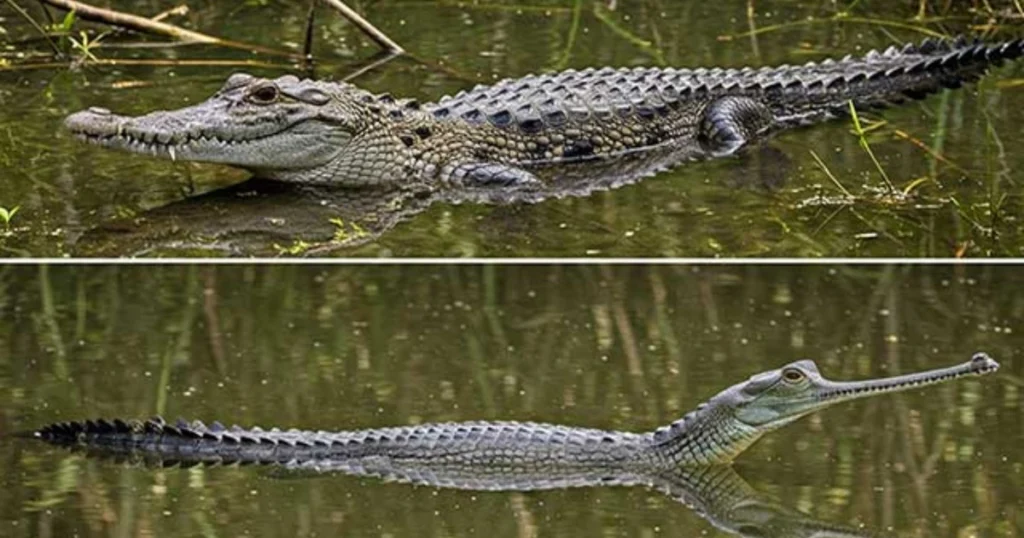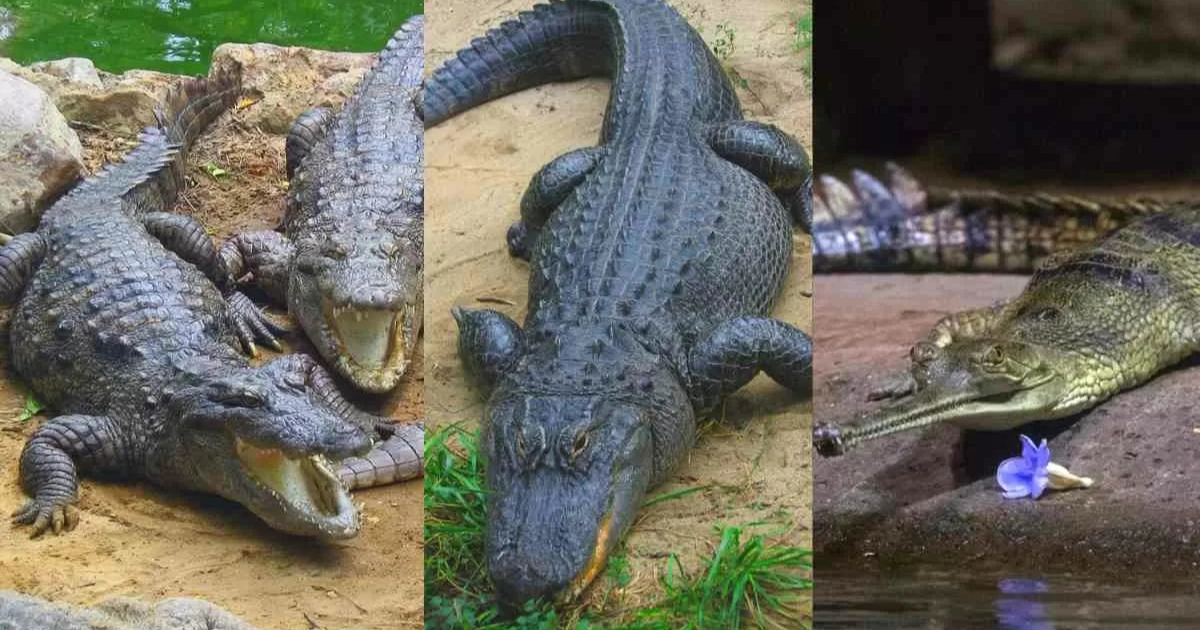Ever wondered if that reptile in a nature documentary or zoo enclosure is an alligator or a crocodile? Or perhaps you’ve heard of the gharial or caiman and didn’t know how they fit into the picture. While all these creatures are part of the crocodilian family, each species has unique traits that set them apart.
This guide will help you identify and distinguish the major types of crocodilians by their appearance, habitat, behavior, and more.

Alligator: The Broad-Snouted Native of the U.S. and China
Habitat: Southeastern United States and parts of China
Key Features:
- U-shaped, broad snout
- Dark, nearly black skin
- Upper teeth visible when mouth is closed
Behavior:
Alligators prefer freshwater environments like swamps, rivers, and lakes. Compared to crocodiles, they tend to be less aggressive toward humans. Their wide snouts make them particularly adept at cracking open turtles and other shelled prey.
Crocodile: The Powerful Predator Found Worldwide
Habitat: Africa, Asia, Australia, and the Americas
Key Features:
- V-shaped, pointed snout
- Olive to grayish-brown skin
- Both upper and lower teeth visible when mouth is closed
Behavior:
Crocodiles are more tolerant of saltwater, thanks to special salt glands in their tongues. This is why they’re often found in brackish areas, deltas, and even coastal regions. They’re also known for their strong bite force and more aggressive nature.
Indian Gharial: The Long-Snouted Specialist
Habitat: Rivers of the Indian subcontinent
Key Features:
- Extremely narrow and elongated snout
- Slender body adapted for aquatic life
- Males have a bulbous nasal growth called a “ghara”
Behavior:
Gharials spend nearly all of their time in the water and are rarely seen walking on land. Their long snouts, lined with sharp teeth, are perfectly designed for catching fish, making them one of the most specialized crocodilians.
False Gharial (Tomistoma): The Misleading Lookalike
Habitat: Swamps and rivers of Malaysia and Indonesia
Key Features:
- Long snout like a gharial, but thicker and more robust
- Dark, mottled skin
- Smaller than saltwater crocodiles, but still sizable
Behavior:
Despite the name “false” gharial, Tomistoma schlegelii is a distinct species. It shares visual traits with the Indian gharial but is genetically closer to crocodiles. It has a more varied diet and is capable of eating mammals and birds.
Caiman: The Compact Crocodilian of the Americas
Habitat: Central and South America
Key Features:
- Smaller size compared to alligators
- Pointed snout
- Bumpier, rougher scales
Behavior:
Caimans are highly adaptable and found in a variety of freshwater environments, from rivers and wetlands to forest ponds. They are excellent swimmers and vary greatly in size depending on species, with some growing as small as 4 feet and others over 13 feet long.
Quick Identification Tips
Here’s a simplified breakdown to help identify each type:
- Snout shape:
- U-shaped = Alligator
- V-shaped = Crocodile
- Long and narrow = Gharial or False Gharial
- Teeth visibility:
- Only upper teeth visible = Alligator
- Both upper and lower teeth visible = Crocodile
- Size comparison:
- Gharials are among the longest
- Caimans are generally smaller
- Habitat preference:
- Freshwater = Alligator, Caiman
- Saltwater/brackish = Crocodile
- Rivers = Gharial, False Gharial
FAQs
What is the main difference between alligators and crocodiles?
Alligators have broader snouts and are usually found in freshwater, while crocodiles have pointed snouts and can live in both fresh and saltwater. Crocodiles also show more teeth when their mouths are closed.
Are gharials dangerous to humans?
Gharials are not considered dangerous to humans. Their snouts are adapted for catching fish and not for attacking larger prey.
Can caimans live in saltwater?
Caimans are generally restricted to freshwater environments. They lack the salt glands that allow crocodiles to survive in marine habitats.
Why are false gharials called “false”?
They resemble the true gharial in appearance but belong to a different genus and have different genetic and ecological characteristics.
Which species grows the largest?
Saltwater crocodiles hold the record as the largest living reptiles, with some males exceeding 20 feet in length.
Internal Link Suggestions from secretsofthegreengarden.com
- How to Build a Wildlife Pond That Attracts Beneficial Species
- Best Native Plants to Support Reptiles and Amphibians
- Creating a Backyard Habitat for Wild Visitors
External Link Suggestions
- National Geographic – Crocodilian Facts
- Smithsonian’s National Zoo – Alligators and Crocodiles
- IUCN Crocodile Specialist Group
Conclusion
Whether you’re exploring wetlands, watching documentaries, or just curious about the fascinating world of reptiles, knowing how to distinguish between crocodilians like alligators, crocodiles, gharials, and caimans is a valuable skill. By paying attention to snout shape, habitat, and behavior, you can quickly identify which species you’re observing. These creatures are ancient survivors, each uniquely adapted to their environment—and worth knowing a little more about.
SEO Summary
- Main keyword: crocodilian species identification
- LSI/NLP keywords used: alligator vs crocodile, how to tell crocodiles apart, types of crocodilians, gharial vs crocodile, caiman features, crocodilian snout shape, crocodile identification guide
- Internal links:
- How to Build a Wildlife Pond That Attracts Beneficial Species
- Best Native Plants to Support Reptiles and Amphibians
- Creating a Backyard Habitat for Wild Visitors
- External links:


Istanbul Archaeological Museum tour Everything was well-explained and interesting. https://ticketiando.com/?p=8943
I simply could not go away your web site prior to suggesting that I really enjoyed the standard info a person supply on your guests Is going to be back incessantly to investigate crosscheck new posts
Chora Church tour Tour guides are passionate about their city. https://qosnetworksmw.com/?p=36075
description https://extended-exchange.xyz/
Balat walking tour Highly recommend for couples and solo travelers. http://kristin-fereira.com/?p=86743
Istanbul Museum of Modern Art tour Smooth check-in and friendly team. https://www.portwaysc.org.uk/?p=927
Istanbul Mosaic Museum tour Great mix of history, culture, and fun. https://gyldigitalsolution.com/?p=14680
Blue Mosque tour Fun, informative, and well-paced. https://www.fly2.travel/?p=91463
можно проверить ЗДЕСЬ
goldcoders
Накрутка живых подписчиков в ТГ вот статья: https://vc.ru/niksolovov/1488381-nakrutka-zhivyh-podpischikov-v-tg-top-25-servisov-2025-goda-moi-reiting Только проверенные бесплатные и платные способы получить больше подписчиков.
Fantastic site A lot of helpful info here Im sending it to some buddies ans additionally sharing in delicious And naturally thanks on your sweat
Süleymaniye Mosque tour Istanbul history tour was fascinating. https://brunet.brefconcept.com/?p=2484
https://telegra.ph/Tot-ce-trebuie-s%C4%83-%C8%99tii-despre-utilizarea-drumurilor-din-Cehia-%C8%99i-necesitatea-unei-vignete-01-12
нажмите
скрипты хайпов
где можно купить аттестат за 11 класс где можно купить аттестат за 11 класс .
провайдеры по адресу краснодар
krasnodar-domashnij-internet004.ru
подключить интернет по адресу
Накрутка подписчиков в ТГ канал бесплатно вот статья: https://vc.ru/niksolovov/1493488-nakrutka-podpischikov-v-tg-kanal-besplatno-top-25-servisov-2025-goda-lichnyi-vybor Только проверенные бесплатные и платные способы получить больше подписчиков.
проститутки микрорайон балашиха реальные проститутки балашихи
интернет
[url=https://hyip-helper.net/]шаблоны хайп проектов[/url]
зайти на сайт
[url=https://hyip-helper.net/]хайп проект[/url]
Beste xxx sites bieden premium inhoud voor volwassenen. Ontdek betrouwbare bronnen voor kwaliteit en privacy.
Take a look at my site :: anal fisting porn movies
https://t.me/s/officials_pokerdom/3391
برای دوستانی که به دنبال یک راهکار مطمئن برای وریفای حساب در بروکرهای فارکس هستند، پیشنهاد میکنم خدمات شوپی را بررسی کنند. این مجموعه به صورت تخصصی، وریفای قانونی حساب های فارکس را با مدارکی ارائه میدهد که کاملاً معتبر بوده و به نام خودتان صادر میشود. این روش دائمی است و ریسک بلاک شدن حساب شما را به صفر میرساند. کیفیت و پشتیبانیشان واقعاً عالی است.
Just wish to say your article is as astonishing.
The clarity in your post is simply cool and i can assume you are an expert
on this subject. Well with your permission let me to grab your RSS feed to keep up to date with forthcoming
post. Thanks a million and please continue the enjoyable work.
Check out my blog; buy xanax without prescrition
یکی از طبیعیترین مدارکی که تا حالا دیدم، آیدی کارت امارات گرافیسو بود. در مدرک آیدی کارت دوبی تمام جزئیات مثل QR، امضا و فونت عربی دقیق رعایت شده. حتی نور کارت زیر زاویه خاص، هولوگرام اصلی رو نشون میده. کیفیتش واقعاً بالاتر از انتظارمه.